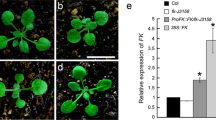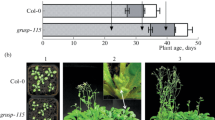Abstract
Flowering, the transition from the vegetative to reproductive phase in plants, is regulated by both endogenous and environmental signals. Exposure to an extended period of stress (such as low nitrate or NaCl) can also promote flowering in many species, but little is known about how these forms of stress regulate floral induction. In this study, we found that stress induced by low concentrations of nitrate or NaCl activated the biosynthesis of gibberellin (GA) as evidenced by increased expression of the GA biosynthetic enzyme GA1. Expression of CO and SOC1 were also enhanced, leading to an acceleration of flowering. The effects of nitrate and NaCl on the photoperiod pathway were distinct, however. Two genes related to the photoperiod pathway, CCA1 and LHY, were repressed only under low NaCl treatment, while expression was unaltered by nitrate. Therefore, we suggest that the biosynthesis of gibberellin (GA) may play an important role in integrating signals induced by exogenous stress to regulate flowering in Arabidopsis.
Similar content being viewed by others
Abbreviations
- SOC1 :
-
suppressor of overexpression of CO 1
- VIN3 :
-
vernalization insensitive 3
- GA :
-
gibberellic acid
- FT :
-
flowering locus T
References
Alexandre C.M. & Hennig L. 2008. FLC or not FLC: the other side of vernalization. J. Exp.Bot. 59: 1127–1135.
Balasubramanian S., Sureshkumar S., Lempe J. & Weigel D. 2006. Potent induction of Arabidopsis thaliana flowering by elevated growth temperature. Plos. Genetics 2: 980–989.
Bernier G. 1988. The control of floral evocation and morphogenesis. Ann. Rev. Plant. Physiol. Plant Mol. Biol. 39: 175–219.
Blazquez M.A., Green R., Nilsson O., Sussman M.R. & Weigel D. 1998. Gibberellins promote flowering of Arabidopsis by activating the LEAFY promoter. Plant Cell 10: 791–800.
Blázquez M.A., Ahn J.H. & Weigel D. 2003. A thermosensory pathway controlling flowering time in Arabidopsis thaliana. Nature Genetics 33: 168–171.
Candau R., Avalos J. & Cerda-Olmedo E. 1992. Regulation of gibberellin biosynthesis in Gibberella fujikuroi. Plant Physiol. 100: 1184–1188.
Chandler J. & Dean C. 1994. Factors influencing the vernalization response and flowering time of late flowering mutants of Arabidopsis thaliana (L.) Heynh. J. Exp. Bot. 45: 1279–1288.
Hayama R. & Coupland G. 2003. Shedding light on the circadian clock and the photoperiodic control of flowering. Curr. Opin. Plant Biol. 6: 13–19.
He Y. & Amasino R.M. 2005. Role of chromatin modification in flowering-time control. Trends Pl. Sci. 10: 30–35.
He Z. 1993. A Laboratory Guide to Chemical Control Technology on Field Crop. Beijing Agricultural University Press, Beijing, pp. 60–68.
Helliwell C.A., Wood C.C., Robertson M., James Peacock W. & Dennis E.S. 2006. The Arabidopsis FLC protein interacts directly in vivo with SOC1 and FT chromatin and is part of a high molecular weight protein complex. Plant J. 46: 183–192.
Hepworth S.R., Valverde F., Ravenscroft D., Mouradov A. & Coupland G. 2002. Antagonistic regulation of flowering-time gene SOC1 by CONSTANS and FLC via separate promoter motifs. EMBO J. 21: 4327–4337.
Hisamatsu T., King R.W., Helliwell C.A. & Koshioka M. 2005. The involvement of gibberellin 20-oxidase genes in phytochrome-regulated petiole elongation of Arabidopsis. Plant Physiol. 138: 1106–1116.
Jacobsen S.E. & Olszewski N.E. 1993. Mutations at the SPINDLY locus of Arabidopsis alter gibberellin signal transduction. Plant Cell 5: 887–896.
Jung H.H. & Kim K.S. 2010. Flowering and growth of adonis amurensis as influenced by temperature and photosynthetic photon flux density. Horticul. Environ. Biotech. 51: 153–158.
Kim S.Y., Park B.S., Kwon S.J., Kim J., Lim M.H., Park Y.D., Kim D.Y., Suh S.C., Jin Y.M. & Ahn J.H. 2007. Delayed flowering time in Arabidopsis and Brassica rapa by the over-expression of FLOWERING LOCUS C (FLC) homologs isolated from Chinese cabbage (Brassica rapa L. ssp. pekinensis). Plant Cell Rep. 26: 327–336.
Klebs G. 1913. Uber das Verhaltnis der Außenwelt zur Entwicklung der Pflanze. Sitz-Ber Akad Wiss Heidelberg Ser B 5: 3–47.
Loeppky H.A. & Coulman B.E. 2001. Residue removal and nitrogen fertilization affects tiller development and flowering in meadow bromegrass. Agron. J. 93: 891–895.
Marín I.C., Loef I., Bartetzko L., Searle I., Coupland G., Stitt M. & Osuna D. 2011. Nitrate regulates floral induction in Arabidopsis, acting independently of light, gibberellin and autonomous pathways. Planta 233: 539–552.
Martínez C., Pons E., Prats G. & León J. 2004. Salicylic acid regulates flowering time and links defence responses and reproductive development. Plant J. 37: 209–217.
Moon J., Suh S.S., Lee H., Choi K.R., Hong C.B., Paek N.C., Kim S.G. & Lee I. 2003. The SOC1 MADS box gene integrates vernalization and gibberellin signals for flowering in Arabidopsis. Plant J. 35: 613–623.
Mouradov A., Cremer F. & Coupland G. 2002. Control of flowering time: interacting pathways as a basis for diversity. Plant Cell 14: S111–S130.
Munns R. 1985. Na+, K+ and Cl− in xylem sap flowing to shoots of NaCl-treated barley. J. Exp. Bot. 36: 1032–1042.
Neta Sharir I., Shoseyov O. & Weiss D. 2000. Sugars enhance the expression of gibberellin induced genes in developing petunia flowers. Physiol. Plant. 109: 196–202.
Nieman R. & Bernstein L. 1959. Interactive effects of gibberellic acid and salinity on the growth of beans. Am. J. Bot. 46: 667–670.
Onouchi H., Igeńo M.I., Périlleux C., Graves K. & Coupland G. 2000. MMutagenesis of plants overexpressing CONSTANS demonstrates novel interactions among Arabidopsis flowering-time genes. Plant Cell 12: 885–900.
Rieu I. & Powers S.J. 2009. Real-time quantitative RT-PCR: Design, calculations, and statistics. Plant Cell 21: 1031–1033.
Schmitz R.J. & Amasino R.M. 2007. Vernalization: a model for investigating epigenetics and eukaryotic gene regulation in plants. BBA — Gene Struct. Expres. 1769: 269–275.
Seo E., Lee H., Jeon J., Park H., Kim J., Noh Y.S. & Lee I. 2009. Crosstalk between cold response and flowering in Arabidopsis is mediated through the flowering-time gene SOC1 and its upstream negative regulator FLC. Plant Cell 21: 3185–3197.
Sharp R., Else M., Cameron R. & Davies W. 2009. Water deficits promote flowering in Rhododendron via regulation of pre and post initiation development. Sci. Hortic. 120: 511–517.
Sheldon C.C., Finnegan E.J., Rouse D.T., Tadege M., Bagnall D.J., Helliwell C.A, Peacock W.J. & Dennis E.S. 2000. The control of flowering by vernalization. Curr. Opin. Plant Biol. 3: 418–422.
Sheldon C.C, Hills M.J., Lister C., Dean C., Dennis E.S. & Peacock W.J. 2008. Resetting of FLOWERING LOCUS C expression after epigenetic repression by vernalization. Proc. Natl. Acad. Sci. 105: 2214–2219.
Storey R. & Jones R.G.W. 1978. Salt stress and comparative physiology in the Gramineae. I. Ion relations of two salt-and water-stressed barley cultivars, California Mariout and Arimar. Funct. Plant Biol. 5: 801–816.
Suárez-López P., Wheatley K., Robson F., Onouchi H., Valverde F. & Coupland G. 2001. CONSTANS mediates between the circadian clock and the control of flowering in Arabidopsis. Nature 410: 1116–1120.
Sung S. & Amasino R.M. 2005. Remembering winter: toward a molecular understanding of vernalization. Ann. Rev. Plant Biol. 56: 491–508.
Valverde F., Mouradov A., Soppe W., Ravenscroft D., Samach A. & Coupland G. 2004. Photoreceptor regulation of CONSTANS protein in photoperiodic flowering. Science 303: 1003–1006.
Wang Z.Y. & Tobin E.M. 1998. Constitutive expression of the CIRCADIAN CLOCK ASSOCIATED 1 (CCA1) gene disrupts circadian rhythms and suppresses its own expression. Cell 93: 1207–1217.
Weiler E.W. 1986. Plant hormone immunoassay based on monoclonal and polyclonal antibodies, pp. 1–17. In: Linskens H.F. & Jackson J.F., (eds), Immunology in Plant Sciences. Springer-Verlag, New York.
Wilson R.N., Heckman J.W. & Somerville C.R. 1992. Gibberellin is required for flowering in Arabidopsis thaliana under short days. Plant Physiol. 100: 403–408.
Yamauchi Y., Ogawa M., Kuwahara A., Hanada A., Kamiya Y. & Yamaguchi S. 2004. Activation of gibberellin biosynthesis and response pathways by low temperature during imbibition of Arabidopsis thaliana seeds. Plant Cell 16: 367–378.
Yang Y.M., Xu C.N., Wang B.M. & Jia J.Z. 2001. Effects of plant growth regulators on secondary wall thickening of cotton fibres. Plant Growth Regul. 35: 233–237.
Zhang M., Cai R.G., Li H.Z., Li J.M., Dai Z.M., Wang Z.L. & Yi Y.P. 2008. Responses of seedling growth and endogenous hormone contents in different wheat cultivars to salt stress. Acta Ecol. Sinica 28: 310–320. (In Chinese)
Zhao X.Y., Yu X.H., Foo E., Symons G.M., Lopez J., Bendehakkalu K.T., Xiang J., Weller J.L., Liu X.M., Reid J.B. & Lin C.T. 2007. A study of gibberellin homeostasis and cryptochrome-mediated blue light inhibition of hypocotyl elongation. Plant Physiol. 145: 106–118.
Author information
Authors and Affiliations
Corresponding author
Rights and permissions
About this article
Cite this article
Liu, T., Li, Y., Ren, J. et al. Nitrate or NaCl regulates floral induction in Arabidopsis thaliana . Biologia 68, 215–222 (2013). https://doi.org/10.2478/s11756-013-0004-x
Received:
Accepted:
Published:
Issue Date:
DOI: https://doi.org/10.2478/s11756-013-0004-x




